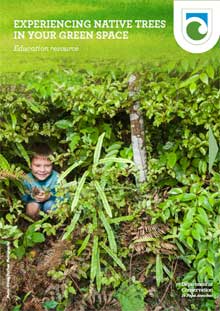This resource is part of the Protecting your environment series, to encourage primary and intermediate students to go outdoors, explore and connect to a local green space.
Published: 2017
Download the resource
Experiencing native trees in your green space (PDF, 5,447K)
Learning outcomes
Using this resource, students can:
- connect with and learn about widespread New Zealand native trees
- identify key native trees
- begin to understand how native plants and trees are part of a wider ecosystem.
Individual sheets
Tree factsheets
- Kōwhai – Sophora microphylla (PDF, 978K)
- Cabbage tree / tī Kōuka – Cordyline australis (PDF, 921K)
- Mānuka / tea tree – Leptospermum scoparium (PDF, 717K)
- Lancewood / horoeka – Pseudopanax crassifolius (PDF, 664K)
- Māhoe / whitey-wood – Melicytus ramiflorus (PDF, 794K)
- Kōtukutuku / tree fuchsia – Fuchsia excorticata (PDF, 628K)
- Lemonwood / tarata – Pittosporum eugenioides (PDF, 819K)
- Patē (Patate) / seven finger – Schefflera digitata (PDF, 816K)
- Rātā (Northern and Southern) – Metrosideros robusta/ umbellate (PDF, 500K)
- Broadleaf / kapuka – Griselinea littoralis (PDF, 671K)
- Nīkau palm – Rhopalostylis sapida (PDF, 971K)
- Silver tree fern / ponga – Cyathea dealbata (PDF, 876K)
- Kahikatea – Dacrocarpus dacrydioides (PDF, 610K)
- Tōtara – Podocarpus totara (PDF, 808K)
- Rimu – Dacrydium cupressinum (PDF, 1,563K)
- Matai – Prumnopitus taxifolia (PDF, 899K)
Tree connection factsheets
- Cabbage tree/ti kōuka connections (PDF, 443K)
- Manuka connections (PDF, 627K)
- Tree fuchsia/kōtukutuku connections (PDF, 350K)
- Other tree connections (PDF, 954K)
- Native trees and their connections with people (PDF, 942K)
Google slideshow
New Zealand trees
Outlines what a tree is, parts of a tree (leaves, trunk, flowers, fruit), NZ trees, their place in an ecosystem and why they are important.
Supporting resources
Curriculum links
Level 1-4 Science
Living World: Life Processes
- L1 & 2: Recognise that all living things have certain requirements so they can stay alive.
- L3 & 4: Recognise that there are life processes common to all living things and that these occur in different ways.
Planet Earth and Beyond: Earth systems
- L1 & 2: Explore and describe natural features and resources.
- L3 & 4: Appreciate that water, air, rocks and soil and life forms (e.g. trees) make up our planet and that these are Earth’s resources.
Nature of Science: Investigating in Science and Communicating in Science
- L 1-4: Extend their experiences and personal explanations of the natural world through exploration, play, asking questions, and discussing simple models.
- L 1-4: Build their language and develop their understandings of the many ways the natural world can be represented.
Science capabilities
- Gather and interpret data
- Use evidence
- Critique evidence
- Interpret representations
- Engage with science
Minor curriculum links
- Science: Living World: Evolution, Ecology
- Nature of Science: Understanding about science; Participating and contributing
- English: Listening, reading and viewing; Speaking, writing and presenting ideas
- Mathematics: Statistics.
Learning sequence
- Introducing native trees in your green space - Using hands-on, outdoor learning experiences, students explore leaves and trees, encouraging interest and connection.
- Planning your investigation and learning about New Zealand trees - Students continue their learning inquiry, reflecting on knowledge and then ask questions about NZ trees and their connections.
- Identifying native trees in their environment- Gathering and reflecting on data. Students add to their knowledge, reflect on predictions and use and critique their evidence/ data about trees.
- Extending thinking about native trees - Explore Māori perspectives. Add to big picture knowledge about the green space and how trees influence the ecosystem.
- Sharing knowledge and taking the next steps- Students share their findings with the community and then take the next steps in exploring their green spaces.
Learning levels
- Primary
- Secondary
Topics
- Forests and green spaces
Curriculum learning areas
- Science
- Social science
Webinars
Webinars are available to view on the Science Learning Hub website. They use the Exploring your local environment resources to model how conservation education can support student inquiry into a local green space:
Special thanks to Science Learning Hub for partnering with us to deliver these fantastic webinars.
Contact
For questions or feedback about these resources, email engagement@doc.govt.nz.
